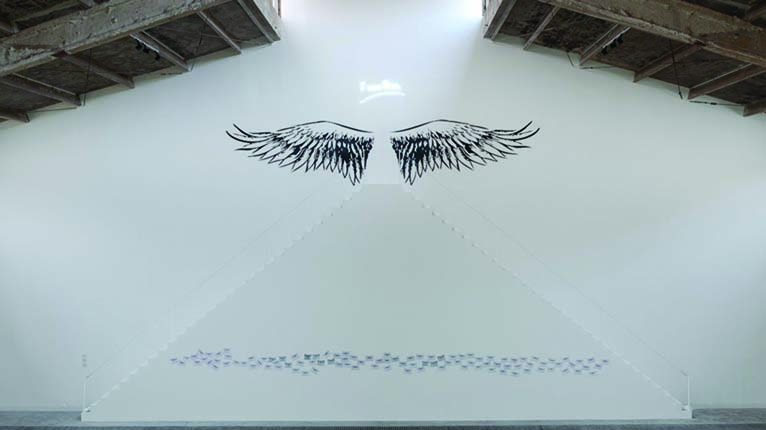MOATAZ NASR: THE TUNNEL
| July 19, 2012 | Post In LEAP 15

To a Chinese audience, the story of contemporary Egyptian history that Moataz Nasr wove through the exhibition was a strange and unfamiliar one. The artist was too focused on links between China and Egypt that transcended the language barrier, from the police barrier at the exhibition entrance to the 32 blue-and-white porcelain vases spread out in a row along the bottom of the gallery walls, above which appeared the Chinese for “freedom, society, work, bread.” Even so, it was obvious that the artist did not do his homework. For example, “bread”— this would be appropriate for Eastern Europe, North Africa, South America, or perhaps as a slogan for the working classes, but it has not been a focal rallying call for any Chinese dissidents or political movements.
Similarly, as in the video work The Echo, the artist’s attitude is vague. The work consists of two clips with identical lines and rhythm. One part shows a certain clip from a film Nasr did during his pro-Soviet period, brimming with intensely nationalistic vocabulary such as “land,” “strife,” “social classes,” and so on. In this way, it served as a kind of contemporary misappropriation and parody. With difficulty, we realize that in the end, in order to draw strength from history and hear its echo, the artist only puts forth a certain type of satire.
Another perspective is that artists also underestimate the Chinese people’s ability to read and understand history. Nasr’s intentions were most obvious in his use of the three eagle insignia of Gamal Abdel Nasser Hussein, Anwar Sadat, and Hosni Mubarak’s governing periods to hint at the despotic regime’s continuity. In an interview, Nasr mentioned the similarity between the pronunciation of the words eagle and ego. Right away it was not hard to see why the artist used the memorial as the form of his interactive installation I am Free, encouraging every audience member to conquer fear and rise above, to learn through experience to become like an eagle, a metaphor for self-worth. But if you only understand Egypt’s three periods of governance through the struggle between the individual and authority, you miss the historical diversity of this time. It is very hard not to see such a presentation as anything but one-sided. The satire lies in Nasr’s use of English grammar to emphasize the relationship between the eagle (Egypt) and the self (Western democracy). In fact, as far back as the 1990s, a few Czech artists gave out cards with the slogan in protest at a few biennials. Can it really be that only those who speak English can become contemporary artists?
It should be said that the significance of Nasr’s exhibition lies not in what he says, but in what happens when we let our experiences of history dictate our approach to that history. Meaning is not self-evident. The history of transformation gives artists the best opportunity to mold cultural subjectivity. Twenty years ago, contemporary Chinese artists made their rounds through similar platforms like the gallery, museum, and biennial, presenting political art. But today, very few people doubt that such appearances violate real and symbolic history. It is hard for us to imagine that such profound and antagonistic political art can come from a commercial mechanism that controls the details down to a picture frame’s dimensions and even the quality of light. This mechanism’s only demand is convenience of distribution, how quickly and agilely its methods of transport, placement, and exhibition are, even to the extent of simplifying statements so they are most easily understood. It establishes a global network that decides the entire configuration of today’s contemporary art. As for Nasr, he makes assumptions about Chinese society for his own political ends. Yet coincidentally, he has not prepared adequately; with regard to Chinese artists, he has cleverly and with great care probed the bottom rung. Today, when faced with political art, these factors make us feel like it is insubstantial and simplistic— a complete mess. Pu Hong (Translated by Caly Moss)


